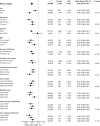Quantifying the Relationship Between Physical Activity Energy Expenditure and Incident Type 2 Diabetes: A Prospective Cohort Study of Device-Measured Activity in 90,096 Adults
- PMID: 36693275
- PMCID: PMC10234747
- DOI: 10.2337/dc22-1467
Quantifying the Relationship Between Physical Activity Energy Expenditure and Incident Type 2 Diabetes: A Prospective Cohort Study of Device-Measured Activity in 90,096 Adults
Abstract
Objective: To investigate the association between accelerometer-derived physical activity energy expenditure (PAEE) and incident type 2 diabetes (T2D) in a cohort of middle-aged adults and within subgroups.
Research design and methods: Data were from 90,096 UK Biobank participants without prevalent diabetes (mean 62 years of age; 57% women) who wore a wrist accelerometer for 7 days. PAEE was derived from wrist acceleration using a population-specific method validated against doubly labeled water. Logistic regressions were used to assess associations between PAEE, its underlying intensity, and incident T2D, ascertained using hospital episode and mortality data up to November 2020. Models were progressively adjusted for demographic, lifestyle factors, and BMI.
Results: The association between PAEE and T2D was approximately linear (n = 2,018 events). We observed 19% (95% CI 17-21) lower odds of T2D per 5 kJ · kg-1 · day-1 in PAEE without adjustment for BMI and 11% (9-13) with BMI adjustment. The association was stronger in men than women and weaker in those with obesity and higher genetic susceptibility to obesity. There was no evidence of effect modification by genetic susceptibility to T2D or insulin resistance. For a given level of PAEE, odds of T2D were lower among those engaging in more moderate-to-vigorous activity.
Conclusions: There was a strong linear relationship between PAEE and incident T2D. A difference in PAEE equivalent to an additional daily 20-min brisk walk was associated with 19% lower odds of T2D. The association was broadly similar across population subgroups, supporting physical activity for diabetes prevention in the whole population.
© 2023 by the American Diabetes Association.
Conflict of interest statement
Figures




Comment in
-
Physical Activity for Type 2 Diabetes Prevention: Some Is Better Than None, More Is Better, and Earliest Is Best.Diabetes Care. 2023 Jun 1;46(6):1132-1134. doi: 10.2337/dci22-0065. Diabetes Care. 2023. PMID: 37220265 No abstract available.
Similar articles
-
Estimation of Physical Activity Energy Expenditure during Free-Living from Wrist Accelerometry in UK Adults.PLoS One. 2016 Dec 9;11(12):e0167472. doi: 10.1371/journal.pone.0167472. eCollection 2016. PLoS One. 2016. PMID: 27936024 Free PMC article.
-
Descriptive epidemiology of physical activity energy expenditure in UK adults (The Fenland study).Int J Behav Nutr Phys Act. 2019 Dec 9;16(1):126. doi: 10.1186/s12966-019-0882-6. Int J Behav Nutr Phys Act. 2019. PMID: 31818302 Free PMC article.
-
Physical activity volume, intensity, and incident cardiovascular disease.Eur Heart J. 2022 Dec 7;43(46):4789-4800. doi: 10.1093/eurheartj/ehac613. Eur Heart J. 2022. PMID: 36302445
-
Usefulness of motion sensors to estimate energy expenditure in children and adults: a narrative review of studies using DLW.Eur J Clin Nutr. 2017 Mar;71(3):331-339. doi: 10.1038/ejcn.2017.2. Epub 2017 Feb 1. Eur J Clin Nutr. 2017. PMID: 28145419 Review.
-
Developmental pathways and programming of diabetes: epidemiological aspects.J Endocrinol. 2019 Jul;242(1):T95-T104. doi: 10.1530/JOE-18-0680. J Endocrinol. 2019. PMID: 30959482 Review.
Cited by
-
Improving postprandial hyperglycemia in prediabetic, sedentary office workers with immediately post-lunch, intermediate-intensity exercise: a comprehensive evaluation using a physical activity tracker, a dietary management application, and continuous glucose monitoring.Diabetol Int. 2025 Mar 22;16(3):504-512. doi: 10.1007/s13340-025-00812-2. eCollection 2025 Jul. Diabetol Int. 2025. PMID: 40607147 Free PMC article.
-
Association between timing and consistency of physical activity and type 2 diabetes: a cohort study on participants of the UK Biobank.Diabetologia. 2023 Dec;66(12):2275-2282. doi: 10.1007/s00125-023-06001-7. Epub 2023 Sep 20. Diabetologia. 2023. PMID: 37728730 Free PMC article.
-
Composite activity type and stride-specific energy expenditure estimation model for thigh-worn accelerometry.Int J Behav Nutr Phys Act. 2024 Sep 10;21(1):99. doi: 10.1186/s12966-024-01646-y. Int J Behav Nutr Phys Act. 2024. PMID: 39256837 Free PMC article.
-
Studying and learning.J Diabetes. 2023 Mar;15(3):200-203. doi: 10.1111/1753-0407.13379. Epub 2023 Mar 7. J Diabetes. 2023. PMID: 36882995 Free PMC article. No abstract available.
-
Changes in physical activity and diabetes risk after cancer diagnosis: a nationwide cohort study.J Cancer Surviv. 2024 Apr 22. doi: 10.1007/s11764-024-01606-2. Online ahead of print. J Cancer Surviv. 2024. PMID: 38647592
References
-
- Aune D, Norat T, Leitzmann M, Tonstad S, Vatten LJ. Physical activity and the risk of type 2 diabetes: a systematic review and dose-response meta-analysis. Eur J Epidemiol 2015;30:529–542 - PubMed
-
- World Health Organization . WHO guidelines on physical activity and sedentary behaviour, 2020. Accessed 1 July 2022. Available from https://apps.who.int/iris/bitstream/handle/10665/336656/9789240015128-en... - PubMed
Publication types
MeSH terms
Grants and funding
LinkOut - more resources
Full Text Sources
Medical

